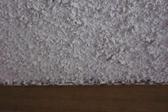
Vermiculite ceilings (also known as popcorn ceilings) were popular a few decades ago, and offered good soundproofing and fireproofing.

What is a popcorn ceiling?
Also known as an acoustic or vermiculite ceiling, a popcorn ceiling is a spray-on, textured ceiling finish. It is often said to resemble popcorn or cottage cheese – hence the name. The popcorn ceiling was once popular in homes, but fell out of favour 1980’s when the harmful effects of asbestos (once a common ingredient in vermiculite) were discovered.
What is a popcorn ceiling for? How does it work?
Popcorn ceilings are great for reducing noise. The spray-on finish is also excellent for hiding dirty, damaged or uneven ceilings. The popcorn mixture is combined with water then sprayed onto the ceiling using a compressor or electric texture sprayer. The ceiling is normally prepared with a PVA primer or white paint first, and several coats of the popcorn mixture are normally applied for optimum results.
What is a popcorn ceiling made of?
The popcorn ceiling mixture can be made from a number of different materials. Some ceilings are made from styrofoam, some are cardboard-based and others are made from a naturally occurring mineral known as vermiculite. While vermiculite is not the same as asbestos, it does often contain it.
Dangers and shortcomings of popcorn ceilings
Asbestos’ role in causing lung disease and cancer means that the maintenance and removal of popcorn ceilings must be approached with extreme caution – and that it’s something you’ll need to pay particular attention to if you’re renovating an old house or apartment. Here are some recommendations to follow if you have a popcorn ceiling.
- Laboratory testing is the only way to tell whether a vermiculite-based popcorn ceiling contains asbestos.
- Address any damage to a popcorn ceiling without delay.
- If there is undamaged asbestos in your home, often the safest, easiest and cheapest way to deal with it is to leave it alone.
Cleaning and repair
Many homeowners choose to remove popcorn ceilings – not for health reasons, but for aesthetics. Popcorn ceilings often appear to absorb the light in a room. They gather dust and cobwebs but can crumble if you try to dust them. Unless they are painted (and painting is another difficult task), popcorn ceilings will disintegrate with water if you attempt to clean them. Some companies offer the application of particular products which are formulated specifically to help disguise the appearance of old, dirty popcorn ceilings. Keep in mind that if your popcorn ceiling is not already painted, the application of this type of product will make removal of the ceiling more difficult further down the track.
Prevalence in modern buildings
Contemporary residential buildings now rarely install popcorn ceilings. Other textured ceiling finishes are available which do not have the same problems as popcorn ceilings. Although they are cheap, good at reducing noise and can improve the appearance of an uneven or damaged ceiling, popcorn ceilings are widely regarded as being out of date and too difficult to maintain.
Advice for removal
Although it is a messy job, unpainted popcorn ceilings can removed relatively easily by soaking the ceiling with a water and vinegar solution, and then scraping the popcorn mixture off. Your ceiling may not contain asbestos, but for safety’s sake it’s best to treat it as though it does. If you do have a popcorn ceiling that you want removed, you should employ a licensed asbestos removal contractor to do the job.
For further information about the removal of popcorn ceilings, get in touch with the Environment Protection Agency (EPA) in your state or territory.
|
Advantages
|
Disadvantages
|





